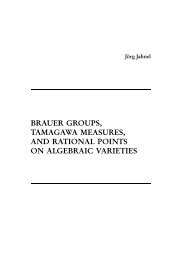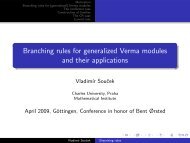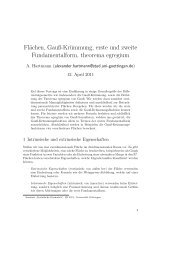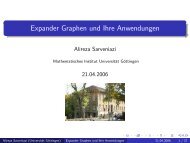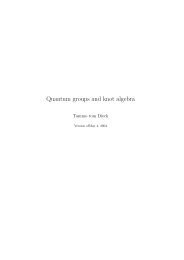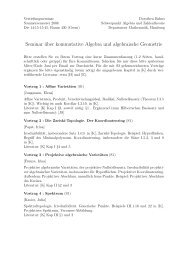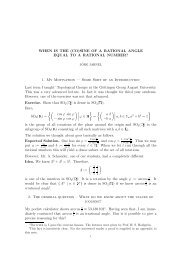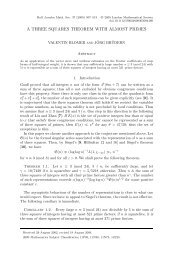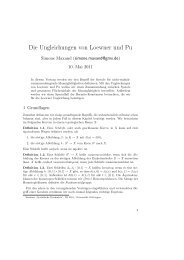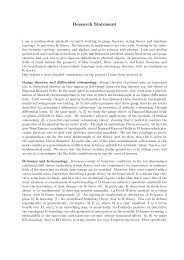Teaching Statement and Statement of Research Plans - GWDG
Teaching Statement and Statement of Research Plans - GWDG
Teaching Statement and Statement of Research Plans - GWDG
You also want an ePaper? Increase the reach of your titles
YUMPU automatically turns print PDFs into web optimized ePapers that Google loves.
Index 3<br />
Introduction<br />
In this short article, I describe briefly the projects that I am currently working<br />
on, <strong>and</strong> the projects that I’d like to work on in the near future. My<br />
primary research interest is in automorphic representations <strong>and</strong> arithmetic<br />
number theory. More specifically, I would like to use Bruhat-Tits Buildings<br />
based on non-archimedian local fields <strong>and</strong> associated automorphic forms <strong>and</strong><br />
representations to solve certain problems in Number Theory, Combinatorics,<br />
<strong>and</strong> Computer Science.<br />
Most <strong>of</strong> my research is centered around Ramanujan (graphs) hypergraphs <strong>and</strong><br />
associated Zeta <strong>and</strong> (L)-functions. Before giving a description <strong>of</strong> projects, I<br />
give an informal overview <strong>of</strong> my construction <strong>of</strong> Ramanujan hypergraphs.<br />
Ramanujan hypergraphs<br />
In my thesis (see : http://www.uni-math.gwdg.de/asarveni/index1.html or<br />
enclosed paper) I studied Ramanujan regular hypergraphs, generalizing the<br />
definition <strong>of</strong> Ramanujan graphs introduced by A.Lubotzky, R.Philips, P. Sarnak<br />
[13], [14]. There are closely related papers by A.Lubotzky B.Samuels <strong>and</strong><br />
U.Vishne [15] ,<strong>and</strong> a beautiful simple construction by W. Lie [12]. The main<br />
difference between these <strong>and</strong> my construction is that I am using a very special<br />
kind <strong>of</strong> algebra, namely the skew polynomial ring F q d{τ} <strong>and</strong> its quotient<br />
field F q d(τ), as the main tools throughout my thesis to arrive at an explicit<br />
construction <strong>of</strong> Ramanujan hypergraphs. These skew polynomial rings also<br />
are very useful in other branches <strong>of</strong> Mathematics, such as Drinfeld Modules,<br />
or Invariant theory. Though the explicit construction is beautiful, it<br />
is not possible to underst<strong>and</strong> this construction without technical arguments<br />
<strong>and</strong> a deep knowledge <strong>of</strong> the geometric nature <strong>of</strong> Buildings <strong>of</strong> type Ãd−1. I<br />
would like to illustrate the rich connections <strong>of</strong> the notion <strong>of</strong> Ramanujan hypergraph<br />
with several parts <strong>of</strong> mathematics, for example with the theory <strong>of</strong><br />
Bruhat -Tits Buildings, with representation theory, with combinatorics, <strong>and</strong><br />
with ‘non-commutative algebraic-geometry’ as the natural search for zeros <strong>of</strong><br />
skew polynomials over finite fields. This viewpoint shows that my construction<br />
is more practical for applications to Computer Science <strong>and</strong> is the most<br />
natural extension <strong>of</strong> the notion <strong>of</strong> Ramanujan graph. Apart from the use <strong>of</strong><br />
the arithmetic skew polynomial ring as specified above, the other important<br />
difference is in making use <strong>of</strong> Lafforgue’s <strong>and</strong> Arthur-Clozel’s results in the<br />
representation theory <strong>of</strong> automorphic forms. Below we quickly review my<br />
explicit construction (for pro<strong>of</strong>s <strong>and</strong> further details see [21]). The explicit<br />
construction shows that the Cayley graph <strong>of</strong> a certain complicated group



